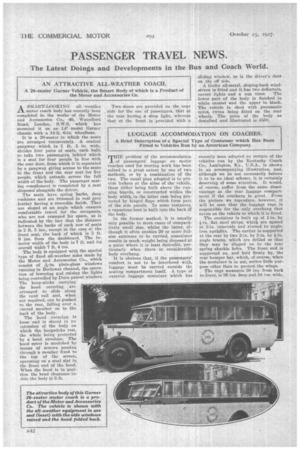LUGGAGE ACCOMMODATION ON COACHES.
Page 68

Page 69

If you've noticed an error in this article please click here to report it so we can fix it.
A Brief Description of a Special Type of Container which Has Been Fitted to Vehicles Run by an American Company.
T"problem of the accommodation of passengers' luggage on motor coaches used for touring work has been solved to a great extent by one of two methods, or by a combination of the two. The usual plan adopted is to provide lockers at the sides of the vehicle, these either being built above the running boards, or constructed within the body width, in the latter case being protected by hinged flaps which form part, of the side panels, In some instances, a capacious boot is built into the back a the body.
In the former method, it Is usually only possible to store cases of comparatively small size, whilst the latter, although it often enables 20 or more fullsize suitcases to be carried, sometimes results in much weight being disposed at a point where it is least desirable, particularly when there is considerable body overhang.
It is obvious that, if the passengers' comfort is not to be interfered with, luggage must be carried outside the seating compartment itself. A type of exterior luggage container which has recently been adopted on certain of the vehicles run by the Kentucky Coach Co.. Lexington, Ky., U.S.A., is shown in an accompanying illustration, and, although we do not necessarily believe it to be an ideal scheme, it is certainly deserving of some attention. It would, of course, suffer from the same disadvantage as the rear luggage oompartment if the overhang be great. From the picture we reproduce, however, it will be seen that the -luggage cage is responsible for the only overhang that exists on the vehicle to which it is fitted.
The container is built up of 1-in. by Fin. flat steel strips, which are spaced at 3-in. intervals and riveted to angleiron uprights. The carrier is supported. at the rear by two 2-in. by 2-in. by Fit). angle braces, which are drilled so that they may be slipped on to the rear spring shackle bolts. The front end is supported on, and held firmly by, the rear bumper bar, which, of course, when the container is in use, serves little purpose other than to protect the wings.
The cage measures 30 ins, from back to front, is 36 ins, deep and 54 ins. wide,
and it is claimed that it can be fixed in position in half an hibur.
Mr. E. M. Carr, the superintendent of the company, informs us that the method has proved successful, but that it has been found difficult to exclude dust. The position in which the cage is carried is such that dust and dirt are thrown up into it as
the vehicle travels. Two ideas have been tested in the hope of overcoming this trouble, one being a canvas pocket and the other an exterior canvas cover, but neither method has • solved 'the problem to the complete satisfaction of the user.
Dust is objectionable as many suitcases admit it quite freely..




















































































































